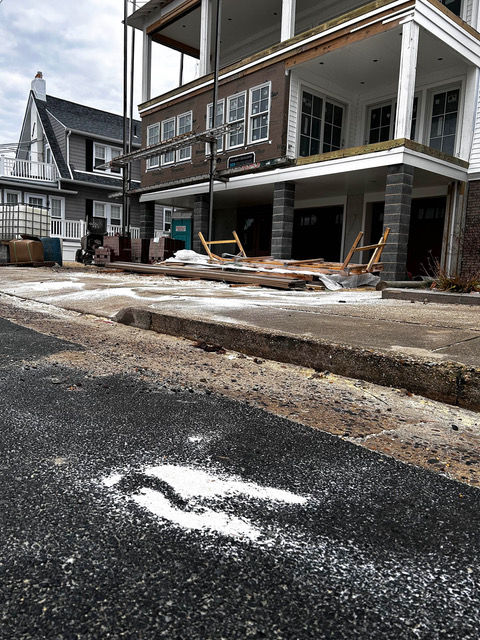
Microplastic shards litter the sidewalks and streets in Margate.
By NANETTE LoBIONDO GALLOWAY
MARGATE – It’s been nearly four months since members of the city’s green team requested the Board of Commissioners adopt an ordinance requiring building contractors to do more to prevent microplastics pollution.
According to Sustainable Margate Chairman Steve Jasiecki, who started investigating the problem in April last year, as word spread about their efforts to get an ordinance on the books to require building contractors to reduce pollution coming from building products such as Trex and AZEK, other municipalities are contacting him to share the ordinance so it can be adopted in their communities.
“We get a lot of requests from environmental commissioners and green teams because it’s a serious issue,” Jasiecki told the commissioners at their meeting Feb. 15. “We tried to find out what kind of other laws are in place, but we couldn’t find anything. All we can find is how to protect employees from the dust that accumulates.”
Jasiecki, who worked in the building trades for 35 years, said the proliferation of microplastics is a new phenomenon caused by recently developed building materials. Not only is pollution being created by sawing plastic lumber, decking, railings, and siding materials, but also from fiberglass insulation and other materials used on job sites. The materials are products of the oil industry, are not biodegradable and can persist in the environment for hundreds or even thousands of years, become airborne and work their way into the soil and waterways.
Jasiecki said microplastics have been detected in marine organisms from plankton to whales, in commercial seafood and even in drinking water.
“Materials have changed over the years, and (the contractors) are not even aware of this.”
He said an educational campaign is needed, but it must be reinforced with an ordinance to encourage improved cleanup procedures.
Jasiecki has taken photos of contractors working on building houses in the city showing how the dust created is blowing into storm drains that lead to the bay and ocean and pose a danger to sea life. That’s how plastics wind up in the food chain he said previously – the fish eat the microplastics, and humans eat the fish.
Mayor Michael Collins said he “appreciates” green team members being persistent in their quest to clean up the environment.
“We are certainly listening,” Collins said. “We are soliciting feedback from our department heads that are affected by the ordinance and working to craft what we believe answers all the questions we have. I agree with the urgency, there’s no reason for us not to move forward in a timely manner, but I would not be in favor of supporting something unless we have the full input from our department heads, which is in process.”
Collins said the city should do its due diligence before proceeding. He would not provide a timeline for introducing the ordinance.
Jasiecki said if the city doesn’t introduce its own ordinance soon, he will share the draft ordinance the green team prepared with other municipalities. The green team’s ordinance requires contractors to use a vacuum attachment on saws to minimize the release of microplastic dust, perform sawing in a confined space to facilitate easy cleanup, use tarps under power tools to catch debris and clean-up work areas at day’s end to ensure the particles do not pollute the area.
Green team member Sherri Lilienfeld, who has worked as a chemical engineer, said early spring is a “critical time” to address the issue.
“Right now, all these homes are framed out, what comes right after that is all the plastic and siding. Spring and summer is when contamination will be all over the place,” she said, pressing the board to come up with a timeframe to introduce the ordinance. “By the end of the summer, there will be too much pollution.”
Department heads should be given a deadline to review the ordinance and address their concerns, she said.
Commissioner Cathy Horn said multiple departments need to weigh-in to ensure proper understanding and enforcement.
Zoning Officer Roger McLarnon said he is preparing a resolution to start working on an educational component for the issue, but an ordinance would be inappropriate at this time until residents and contractors are made fully aware of the problem. Each permit filed in the Construction Office receives a flyer about the issue, he said.
“We are acting on it,” McLarnon said. “We have to be careful penalizing people for something they are not aware of.”
Lilienfeld said she is willing to help with education and that the city might consider developing an incentive program to reward contractors for addressing pollution.
In the meantime, Sustainable Margate is working to create awareness of the problem and enlist the support of other community members to encourage the commissioners to do something about it.
The Sustainable Jersey Atlantic-Cape May County Hub group, which includes green teams from the two counties, will be holding an online meeting Tuesday, Feb. 20 and one of the agenda items will be “Ocean Friendly Construction.” The event is free and open to the public but pre-registration is required at http://tinyurl.com/hub20FebRoundtable.
“If more people see it as a problem, they need to show up at a commission meeting and make their thoughts known,” Lilienfeld said.
Copyright Mediawize, LLC 2024


